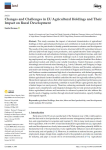Herman E. (2025). Changes and challenges in EU agricultural holdings and their impact on rural development. Land, 01/05/2025, vol. 14, n. 5, p. 1080.
https://doi.org/10.3390/land14051080
https://doi.org/10.3390/land14051080
| Titre : | Changes and challenges in EU agricultural holdings and their impact on rural development (2025) |
| Auteurs : | E. Herman |
| Type de document : | Article |
| Dans : | Land (vol. 14, n. 5, May 2025) |
| Article en page(s) : | p. 1080 |
| Langues : | Anglais |
| Langues du résumé : | Anglais |
| Catégories : |
Catégories principales 06 - AGRICULTURE. FORÊTS. PÊCHES ; 6.5 - Gestion des ExploitationsThésaurus IAMM EXPLOITATION AGRICOLE ; STRUCTURE AGRICOLE ; TAILLE DE L'EXPLOITATION AGRICOLE ; DEVELOPPEMENT RURAL ; PERFORMANCE ; EVALUATION DE L'IMPACT ; UNION EUROPEENNE ; EUROPE |
| Résumé : | This study examines the impact of structural characteristics of agricultural holdings on their agricultural performance and contribution to rural development in EU countries over the past decade to identify potential measures to enhance rural development. The results of the paired samples t-test reveal a structural shift in EU agriculture between 2010 and 2020 toward larger, more productive, and capital-intensive farms alongside a decline in small-scale and subsistence farming, improved agricultural incomes, and rural economic growth. However, persistent challenges such as rural depopulation, declining employment, and ongoing poverty remain. A cluster analysis identified five distinct agricultural models and reflects some notable transitions: Eastern European countries increasingly moved toward mixed farming (e.g., Latvia, Lithuania, and Hungary) or large-scale commercial farming (e.g., the Czech Republic, Estonia, and Slovakia), subsistence and small-scale farming became more concentrated in Bulgaria and Romania, and Western and Northern countries maintained high levels of modernization, with Ireland progressing and the Netherlands standing out as a distinct high-tech agricultural model. The five distinct agricultural clusters identified underline the need for regionally tailored policies. Hierarchical regression shows that while improvements in agricultural performance, particularly increased labor productivity, contribute to rural GDP per capita growth, they have a limited impact on rural poverty. Therefore, enhancing sustainable rural development requires more comprehensive and integrated strategies that not only promote productivity-driven agricultural reforms and innovation in advanced systems but also address the specific needs of lagging countries through structural transformation, capacity building, and targeted support. |
| Cote : | En ligne |
| URL / DOI : | https://doi.org/10.3390/land14051080 |







